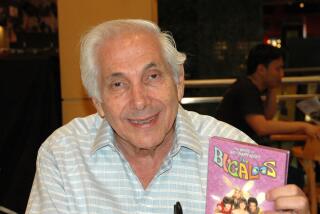Mr. McGruff’s Puppet Power Joins Battle Against Drugs
- Share via
When 20 first-graders at the Hawthorne School in Beverly Hills were told it was story time, they quickly formed a semicircle on the library rug. But to their surprise, librarian Bernice Barth began talking about aspirin, marijuana and cocaine instead of princesses and fairy tales.
Several students began to fidget during the 15-minute question-and-answer period. However, the storyteller recaptured their attention with a hand puppet known as Mr. McGruff.
The Beverly Hills School District adopted the McGruff Elementary School Puppet Program last year to teach students as young as 5 not to use drugs. The program combines storytelling, puppetry, music and dance to get its message across.
“Who can tell me the difference between a good drug and a bad drug?” Barth asked. “And when should you take medicine?”
Hands waved eagerly to be recognized. “A good drug is like an aspirin that you take for a headache or when you have a temperature,” said Emily Sedaghai-Pour. “But you should only take medicine when your mother, father or doctor gives it to you.”
Blake Megdal, 6, warned classmates not to talk to strangers and “never take anything from strangers because they might try to give you bad drugs.”
Barth was animated and enthusiastic, but it was McGruff who mesmerized the youngsters.
“Hi, girls and boys,” Barth said in her natural voice, while manipulating the two-foot hand puppet.
“Mr. McGruff! Mr. McGruff!” the children shouted.
The shaggy brown dog, clad in a beige trench coat, plaid slacks and brown shoes, did not need an introduction. McGruff, known as the “watchdog of crime,” symbolizes efforts by the National Crime Prevention Council and the Advertising Council to “take a bite out of crime.”
He is an effective teaching tool, Barth said, because children relate to cartoons and fairy tale characters.
“Puppets and toys are non-threatening because children can instill (in them) human qualities,” Barth said. “Children also regard stuffed animals and puppets as friends who don’t ask anything in return.”
Mr. McGruff is not a regular television cartoon character. But Barth said his recognition and popularity have increased as a result of anti-drug and anti-crime commercials on television.
Carol Katzman, director of educational services for the school district, said the McGruff safety and substance-abuse program meets state requirements and is part of a comprehensive health education program.
According to Katzman, the district’s health education program took three years to develop. Designated a model project by the state Department of Education, the program will be started in other school districts in November.
“Our comprehensive program teaches wellness and self-responsibility. And we believe that puppets can send powerful messages to children,” Katzman said.
Barth said she found puppets to be excellent teaching tools. The 22-year district employee also said she never changes her voice when working with puppets.
“Children know that puppets and toys are not real,” Barth said. “They believe in fairy tales and become a part of the performance. Puppets and creative storytelling are a meaningful part of any child’s learning experience.”
With their eyes glued to the puppet, students listened attentively when Barth started to lip-sync Mr. McGruff’s anti-drug tune from a cassette.
“Drugs will mess up your mind. Drugs won’t help you to grow. You’ll be wasting your time. No, no, no. Don’t waste your time.”
More to Read
Sign up for Essential California
The most important California stories and recommendations in your inbox every morning.
You may occasionally receive promotional content from the Los Angeles Times.













